Cycling: The Tourism of Tomorrow
Cycling tourism offers endless possibilities for slow travel and emission-free sightseeing.
We live in unprecedented times in which we are rapidly reaching the point of no return for the planet. The tourism and transportation sectors have important roles to play in reducing our environmental impact and cycling tourism can make a significant contribution here if it is supported on the European, national and local levels.
At the European Cyclists’ Federation (ECF), we believe that there is no way forward to address climate change and reach a decarbonized future without substantially more cycling. As world leaders are meeting at COP27 in Egypt, we look at how more cycling can help the tourism sector not only reduce its carbon emissions, but also encourage biodiversity regeneration and resilient communities.
“Europe will not achieve its 2030 goals without urgent action during the next 10 years to address the alarming rate of biodiversity loss, increasing impacts of climate change and the over-consumption of natural resources.” This is the stark warning laid out in the European Environment State and Outlook Report (SOER 2020) reminding us that we must act fast and effectively if we are to combat the climate crisis.
One of the biggest threats for biodiversity loss is climate change, and one of the major causes of climate change is biodiversity loss (as forests have the capacity to act as natural carbon sinks). To reverse this vicious cycle, actions towards decarbonization and biodiversity restoration must be developed hand-in-hand.
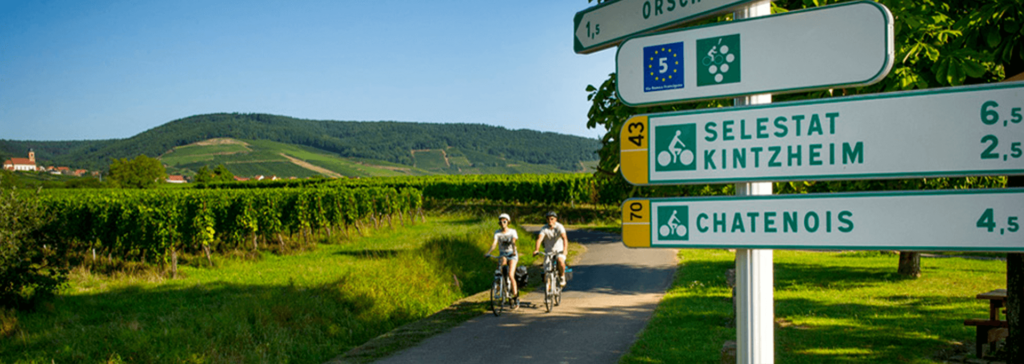
In June 2021, the UN Decade on Ecosystem Restoration, a global rallying cry to heal our planet, was launched to prevent, halt and reverse the degradation of ecosystems worldwide. Rethinking the way we move has an important role in addressing biodiversity loss. Transport causes 24% of global GHG emissions and is a big cause of the pollution and environmental degradation that threatens biodiversity. It has also been estimated that tourism contributes 8% of global GHG emissions. Considering this crossover, there’s simply no way we can address climate change and think of a decarbonized future without changing the way we travel.
Unsustainable travel patterns and carbon-based transport are not only threats to the planet and its environment, but also to the well-being of societies and communities. The negative impact of tourism models that do not acknowledge the limited capacity of natural resources and the undesirable impacts on local communities, were present long before the pandemic.
An over-consumption of resources and an increase in pollution stresses ecosystems, forcing them to lose their capacity to recover. Not to mention the other side effects felt by communities, as unsustainable tourism can reduce the overall quality of life in places (such as over-crowded touristic areas or the over-pricing of housing).
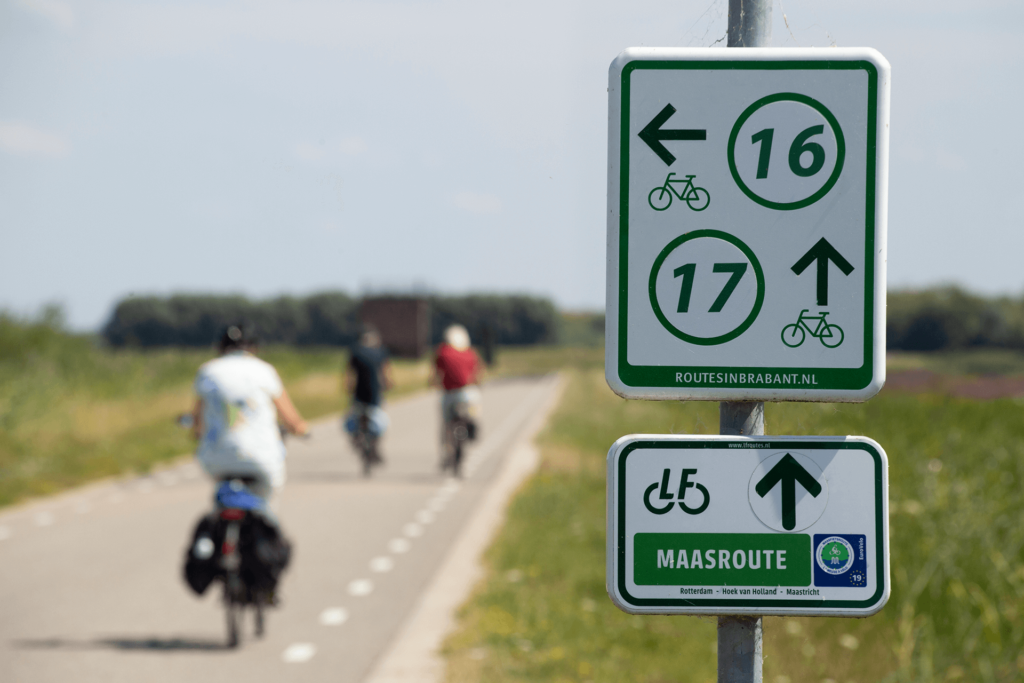
Reimaging the way we travel
Is it now possible to use the opportunity of a ‘recovering’ tourism sector to reimagine the way we travel? Is it possible for tourism to reduce its detrimental environmental and social impact in order to generate positive ripples by restoring life and ecosystems, supporting the creation of vibrant communities and boosting local economies?
To reimagine the way we travel in the Decade on Ecosystem Restoration, a good place to start is to travel in the greenest, smartest and most inclusive way possible. At ECF, we are working to increase the global levels of cycling with the conviction that it has the capacity to blend in with achieving a decarbonized, healthy, inclusive and green future. One of our flagship initiatives is EuroVelo, the European cycle route network: 17 long-distance cycling routes that cross and connect the European continent. EuroVelo is a ’living’ initiative that, when completed, will total 90,000 kilometers spanning over 42 countries.
We believe that with the multiple crises the planet is facing that there is an opportunity for change. The shifting in travelling patterns during the pandemic has supported the increase of cycling and cycling tourism in Europe. According to data collected at ECF, based on the monitoring data of EuroVelo route usage in partnership with Eco-counter, we can confirm the global trend that cycling and cycling tourism is booming – the latest figures show increases in usage between 10-45% for the year 2022 so far, compared to the same period in 2019. Travel behavior is also shifting, tourists are looking for more authentic experiences; outdoor activities, exploring rural areas and domestic traveling are also on the rise.
Transport causes 24% of global GHG emissions.
Source: IEA
We want to take advantage of the momentum that cycling tourism is experiencing right now and the related opportunities it can have in bringing life to rural communities promoting them as cycling destinations, and in encouraging a ‘slow’ tourism, which can take care of the local communities and their environment.
Promoting more cycling tourism will help us change the way we travel and support biodiversity protection and restoration during our holidays. If we have more cycling in the global agenda, it will improve conditions to get more people engaging with everyday cycling and leisure.
Cycling is a safe and healthy option that benefits us as individuals in many ways. Its benefits go beyond physical exercise: the feeling of freedom, reconnecting to nature, and life-changing adventures are just some examples of how travelling by bike can contribute to a feeling of well-being, improving our social, physical and psychological health.
Cycling tourism can repurpose unused infrastructure, improve rural connectivity, bring life to remote areas and boost local economies. Especially when combined with public transport, cycling tourism can also notably reduce the carbon footprint of the tourism sector and can therefore bring us closer to a decarbonized future. This way of travelling helps to disperse tourism flows, extend the holiday season and access natural areas with a minimal impact. It has the capacity to support the regeneration of ecosystems and it is aligned with regenerative travel principles.
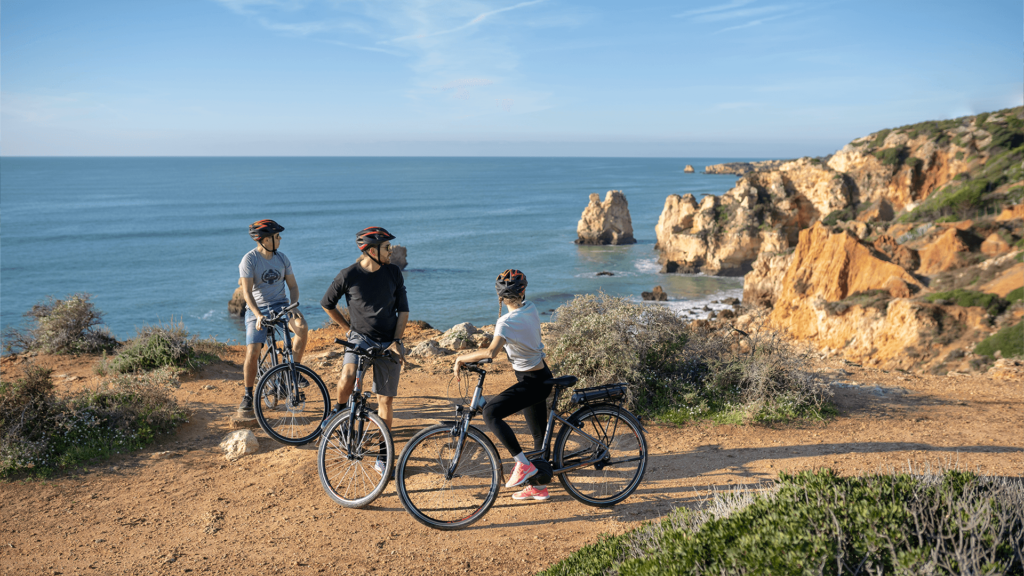
Integrate cycling routes in Europe’s TEN-T
The EU’s Trans-European Transport Network (TEN-T) is the bloc’s flagship transportation policy coordinated by the European Commission together with national governments. TEN-T consists of a primary network of roads, railway lines, inland waterways, ports, maritime shipping routes, airports and railroad terminals. Unfortunately cycling is not included in the network.
Including cycling in the network would improve the connectivity, efficiency and sustainability of TEN-T across the continent. It would also unlock access to new funding for cycling projects.
The new text that will define the EU’s trans-European transport core network development for 2030 is under revision and ECF is recommending amendments to the revision proposal presented by the European Commission in December 2021. In its position paper, ECF strongly recommends that cycling be properly integrated in TEN-T to promote active mobility and achieve positive modal shift towards sustainable transport.
Including EuroVelo, the European cycle route network, within the TEN-T would go a long way to securing cycling’s rightful place as an effective climate solution. TEN-T infrastructure development projects are often hugely-missed opportunities to develop cycling infrastructure alongside other infrastructural investments at a fraction of the entire cost of the project.
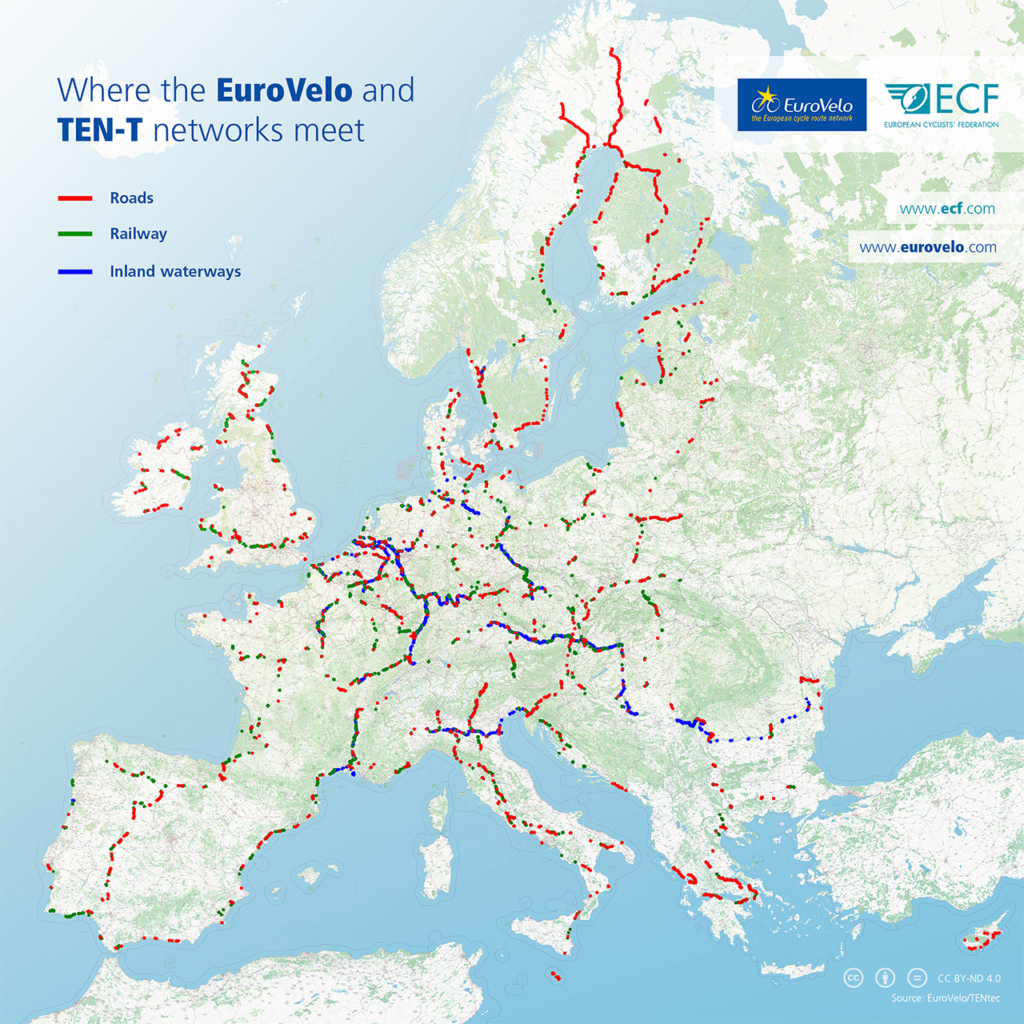
If cycling is not recognized, it is often the case that such large infrastructure projects negatively impact local cycling networks. For example, a ring road creating a barrier between suburbs and the city center, or a railroad upgrade cutting towns in half. The opposite can also be true: well-developed cycling routes can encourage the development of surrounding local networks. There are many more benefits to including a partially developed cross-border long-distance cycling network with EuroVelo that can support the needed change of travelling patterns. You can learn more about them and find out how you can add your support towards getting more cycling in the TEN-T at the European Cyclists’ Federation website.
Changing the way we travel brings us closer to achieving the UN Sustainable Development Goals (SDGs) through rethinking tourism, developing sustainable mobility and encouraging a slow form of travel that leaves a positive impact on communities. Travelling by bike is a key activity for achieving the ‘tourism of tomorrow’ – a tourism that cares for communities and territories and respects the limits of the planet.
The chance to act is now, and an impactful solution is just two wheels away. Hop on your bicycle on your next holidays and discover EuroVelo. Allow yourself to explore territories through new lenses and keep growing the movement to change the way we travel.
GPX Tracks now available on EuroVelo
On 21 November 1997, EuroVelo, the European cycle route network, was launched in Logroño, Spain. Back then the EuroVelo initiative was a mere vision of a dream to connect Europe by bike. But fast forward to the present, 25 years later, it is now a network of long-distance cycle routes criss-crossing and uniting the European continent, with over 90,000 km of cycle routes of which 64% are ready to use.
One of the original aims of developing a European cycle route network back in the late 1990s consisted of fostering the potential of such a network to lay the foundations for developing cycling tourism in Europe, and generate positive impacts for economies, society and the environment.
EuroVelo is a living project. Every year the overall quality of the network improves and new sections are realized, thanks to a coordinated effort between the network of National EuroVelo Coordination Centres and Coordinators (NECC/Cs), developing and communicating the routes at the national level, and the ECF’s EuroVelo Management Team working at the transnational level. Every three years, partners can also apply for new extensions to be added to the network.
EuroVelo is acting as a backbone for cycling tourism across Europe, allowing countries to use the routes as a reference to develop adjacent national, regional and local cycle networks, fostering cycling tourism to boost local economies and transforming the tourism sector to one that is greener, healthier and more inclusive.
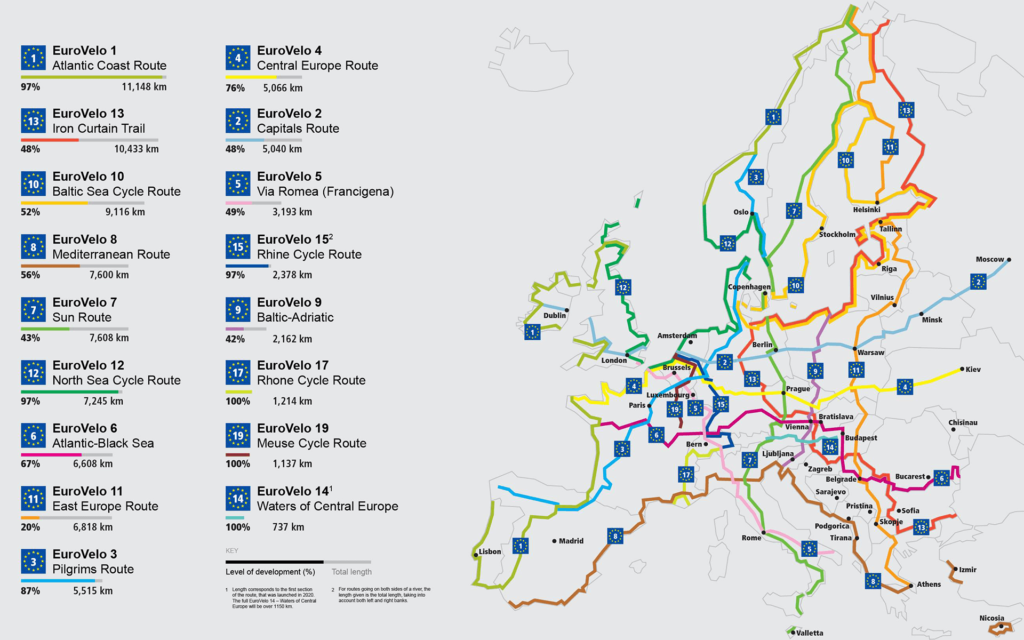
25 years after the launch of the EuroVelo network, the EuroVelo website added a much-requested feature: the ability to download the GPX tracks of EuroVelo routes. Given that EuroVelo is a living project, not all sections of the network are fully developed so far. This is one of the reasons why GPX tracks of the routes were not available for download on www.EuroVelo.com until now. A lot of coordination has been needed to find the best way to share the tracks of a 90,000 km cycle network still in development and subject to change over time.
But now, the GPX tracks download button is finally available on EuroVelo route pages and stage pages. GPX tracks can be downloaded either for developed sections only, or for the full EuroVelo route or stage (only the developed sections can be downloaded for the routes crossing France, Portugal and/or Spain). Downloaded tracks are made of shorter sections (the suggested “daily sections”) of about 50 km.
For each of them, the “route development status” is indicated in the track segment’s name: route sections can be certified, developed with EuroVelo signs, developed according to national standards, under development or at the planning stage. When downloading EuroVelo GPX tracks it is required to read the disclaimer, which includes a description of the development statuses as well. More information on how to plan a cycling trip using EuroVelo GPX tracks can be found on the EuroVelo website.
After all these years of coordinated efforts, the vision of a European cycle route network has become a European success story. To mark this milestone of the EuroVelo network laying the foundations for developing cycling tourism in Europe, ECF will be celebrating the 25 years of EuroVelo with an online event on 21 November 2022.